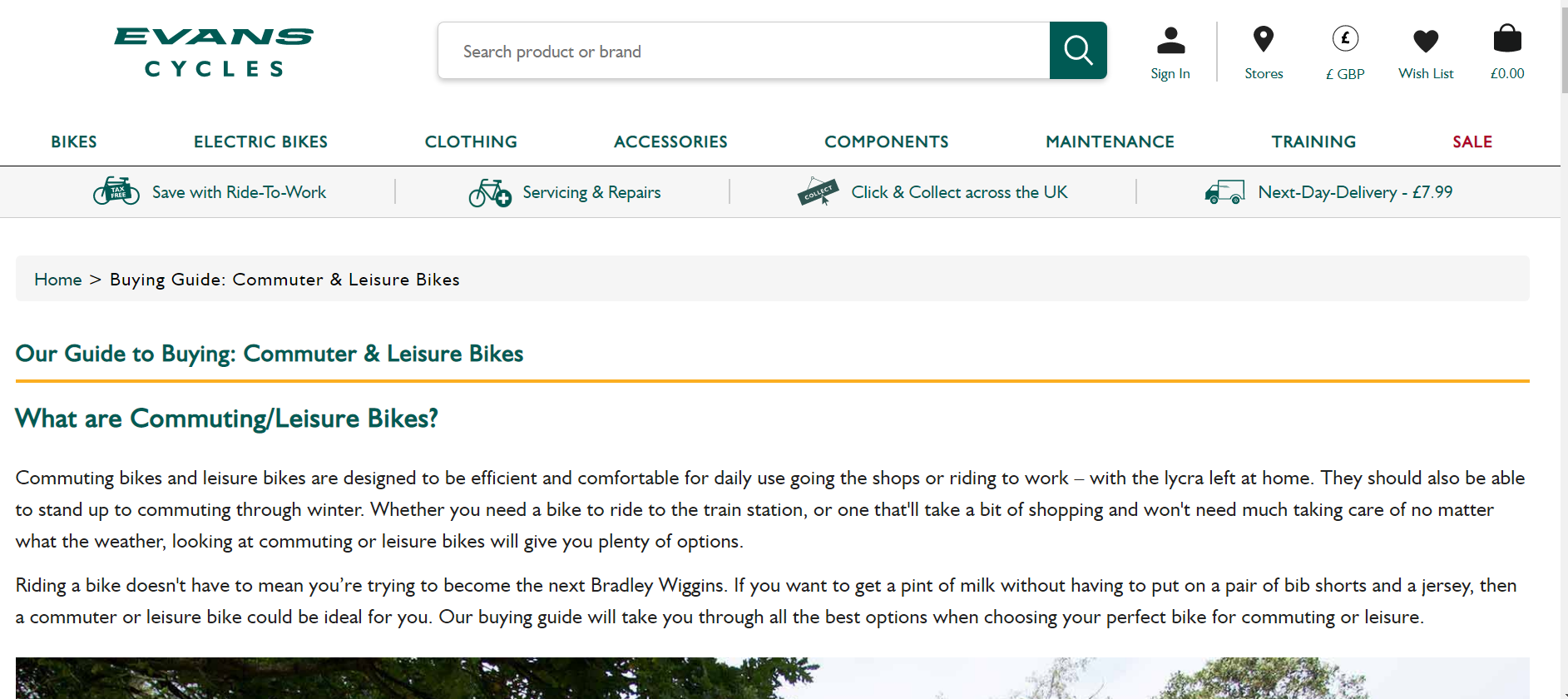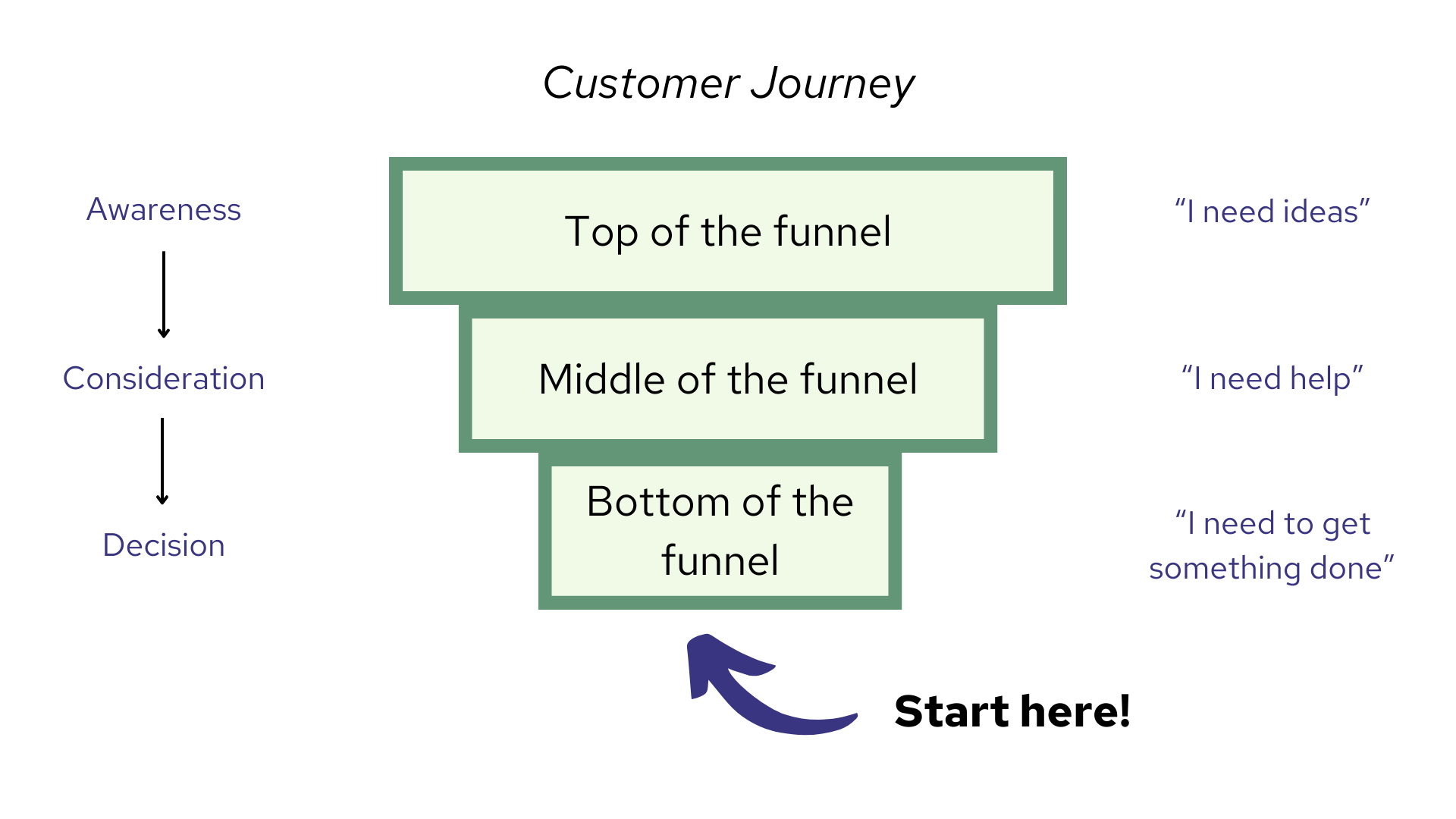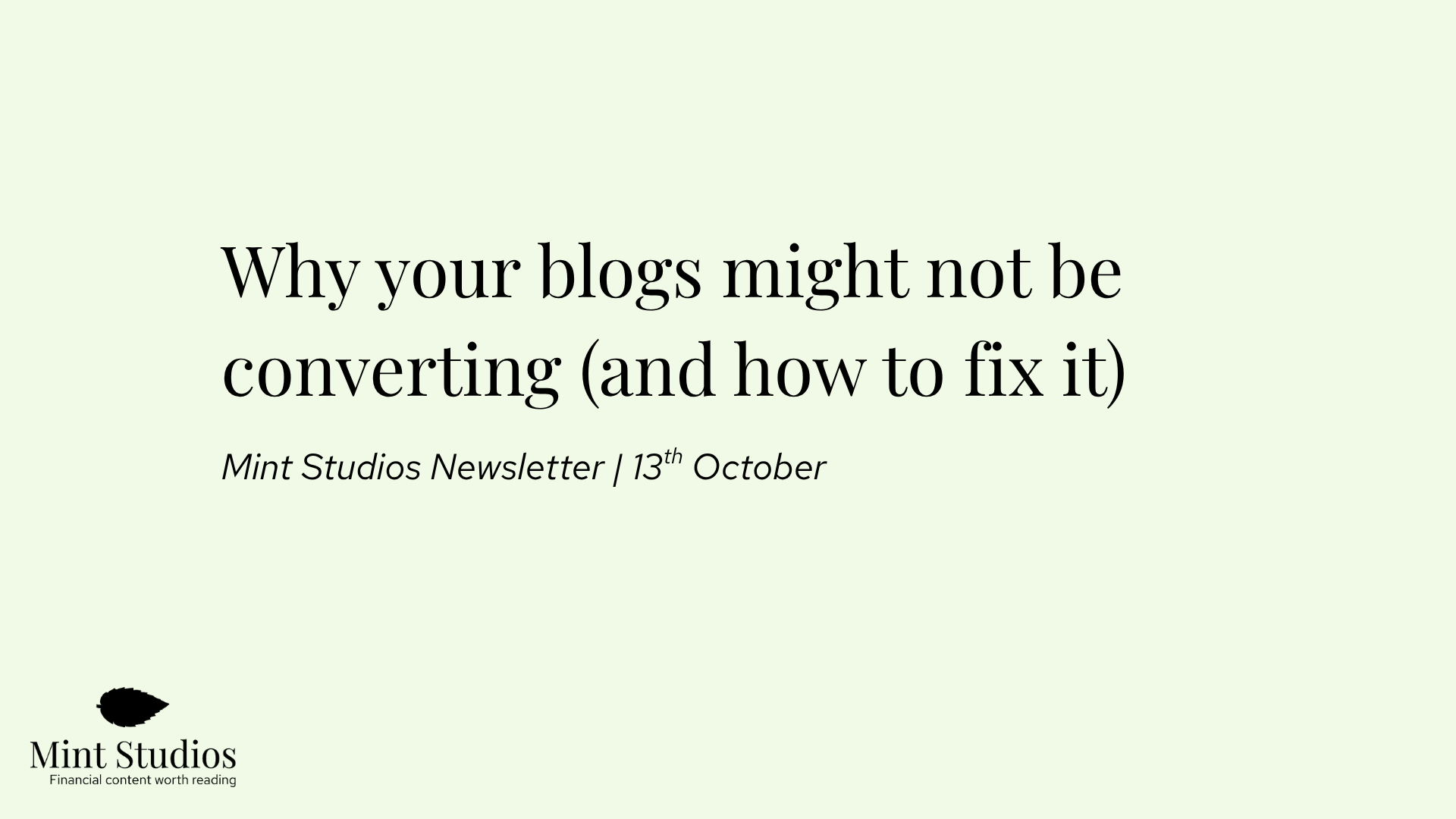It’s a Tuesday morning, the alarm rings at 7 am.
Like many of us, the first thing you do in the morning is check your phone. You see an email from HR, a newsletter from a publication and most exciting of all: 5 emails from your product management tool. 5 new customers have signed up.
The excitement and dopamine hit from those emails gets you excited and you’re ready to tackle the day.
Now imagine that, but the number steadily keeps on increasing. Every day and every week, you’re signing up new customers.
It’s not a dream. It’s true, and it’s possible. When content is doing your heavy lifting, this happens all the time. At Mint Studios, we get several of those emails per week. For our clients, we’ve gotten tens and even hundreds of those emails per month.
That’s what content marketing does. It’s the art of attracting customers rather than chasing them.
Sounds ideal?
Let’s start from the beginning.
Table of Contents:
- What is content marketing?
- What are examples of content marketing?
- How to get started with a fintech content marketing strategy
What is content marketing?
Content marketing involves producing information that educates your customers.
This could be via videos, articles, podcasts, events, social media and a lot more. With these various media types you’ll be answering your customers’ most important questions and educating them on the topics you know most about.
As we can see, content can come in a lot of different formats, but written content — using SEO — is one of the most popular ones.
Why is that? Because when someone has a question, where do they go? Google. And Google is where you’ll find written answers for your questions.
The second largest search engine is Youtube: some people will prefer looking up questions on Youtube, and that’s where video comes in.
But for quick and clear answers, you’ll probably go to Google.
Let’s look at an example. Say you’re looking for “best bicycles for commuting”. You click on the third result, and start reading the article.

This Evans Cycles blog post is quite comprehensive and does a good job at answering your questions (see how they’ve answered several questions within the article?). Based on that article, you decide to buy a Pinnacle Hybrid bike.
Because you’re happy with the answer you’ve found (search intent has been satisfied), next time you see an article written by Evans Cycles, you’re more likely to trust it. When it’s time to buy a cycling helmet, shorts and lights, you might be more inclined to buy it from them.
Evans Cycles has built your trust. Which means when you’ve broken your bicycle or need a replacement, you might head to them to get it fixed (they have local stores all around the UK). They’ve won your business.
The point is: by answering your questions, Evans Cycles has won your trust and therefore made a sale without even needing to contact you. That’s the power of content marketing.
Content marketing is not just a marketing strategy; it’s a mentality. It’s choosing to be transparent and honest, and deciding to educate your customers — even if that means they would pick a competitor.
Do you have the “content marketing mentality”? Here’s an easy way to find out: if a customer came to you with questions and you realised that a competitor of yours would be a better fit than you, would you refer them over?
If you answered yes, then you have the content marketing mindset. If you answered no, then it’s very likely you’ll be losing out to competitors who say yes.
What’s the difference here? In two words: customer centricity. If you want to be truly transparent and empower your customers, then you need to be willing to cover the good, the bad and the ugly.
Content is inherently customer centric: you’re choosing to educate your customers and allow them to make their own decisions, rather than telling them what to do. If you want to be truly customer-centric, then you need to follow through on all fronts.
Content marketing in fintech
Let’s dive into why content marketing is especially powerful in fintech and financial services.
Do you remember what you did when you first realised you had to pay taxes? Or when you decided you wanted to buy your own home? Or even when you started getting interested in crypto?
I do: I went to Google. I searched stuff like “taxes as self-employed”, “ltd vs self-employment” and “tax brackets scotland”.
In school, no one teaches us about taxes, how to set up a business or what a mortgage is. So unless you have a family member who’s a financial advisor, most of us turn to the next best thing: the internet.
As an individual, finding the right information can be frustrating. As a financial technology company, there’s an opportunity here: helping fill the gap of financial education. And before you say anything, yes this works for both B2B and B2C.
In the B2C finance world there’s a lot of jargon, contradicting information and confusing concepts. This is especially true when it comes to things like taxes, where it is our responsibility to know how much we owe.
In the B2B finance world, this is also true for topics such as Open Banking, where merchants and banks need to be educated on what Open Banking is in order to fully understand and implement it.
As a fintech startup, you have a special opportunity to educate your target market by answering questions they’re typing into Google. Because it’s finance related, the demand is high. Because it’s content, you can turn that into an acquisition channel. And just like that, you get leads by answering your customers’ questions. Getting your content to do the heavy lifting means that you can focus on improving your product, talking to customers and growing the company, rather than selling.
This is why SEO and specifically finance SEO works so beautifully if your product is something that usually people don’t quite understand and turn to Google for help. This could be taxes, cryptocurrencies, investments and a lot more.
And that’s just the beginning. That content can also be used to support your sales team, to help raise brand awareness and create opportunities that you didn’t even think existed. More on that later.
What are examples of content marketing in fintech?
What does it look like in practice?
Now that you understand what content marketing is and why it’s so powerful, it’s useful to see how real fintech companies and their marketing teams are using content marketing as an acquisition and retention tool. Here are some companies we believe are doing a great job.
TaxScouts
TaxScouts is a UK based company that does tax returns at an affordable price.
Their articles are well written, well-formatted and cover some of the most important topics their target audience is asking.
They’ve written articles that answer important questions, such as:
- “capital gains on gifted property”: Do I need to pay Capital Gains Tax if I gift property?
- “tax payable on lottery winnings”: Do you need to pay tax on lottery winnings?
- “Capital gains tax allowance uk”: What are Capital Gains Tax rates in UK?
- “Not paid tax for 15 years”: I’ve not done a tax return for 20 years
Look at the last one for a moment. Someone searching “not paid tax for 15 years” is clearly distressed, and maybe even panicking. Taking the time to give all the information they need on one page is a great way to build a relationship with a potential customer. If you’re a marketer, you’ll understand that this piece of content is doing a big service to your product and company.
TaxScouts have also put together separate pages for tax calculators, including
Answering these specific questions is what allows TaxScouts to get nearly over half of their traffic via search.

TaxScouts is a perfect example of a fintech company that is using content to answer customer questions, build trust and use content to drive acquisition and retention.
GoCardless
GoCardless is a payment provider that allows businesses to set up recurring payments with customers. Since they are B2B, their content is more technical and aimed towards decision makers at companies.
But that doesn’t stop them from answering important questions that businesses may have. Such as:
- What is a PO number: What is a PO number?
- Off balance sheet financing: What is off-balance-sheet financing?
- EFT payment meaning: What is an EFT payment?
Just because your target market is a business, doesn’t mean the decision maker won’t be looking things up on Google.
GoCardless is a perfect example of a B2B fintech company that has nailed content and digital marketing.
Credit Karma
Across the pond, in the US, we’ve got Credit Karma. They’re also doing a great job with content marketing.
They are B2C, and post a lot of content on credit cards, credit scores and debt. Some of the main questions they are answering are:
- What is a good time to refinance your car: When should I refinance my auto loan?
- Car loans for veterans: Car loans for veterans: Resources for financing your next car
- How much do credit repair companies charge: How do credit repair companies work?
These are real questions that people are asking, and Credit Karma answers each one and appears on the first result of Google.
Take the last one “how much do credit repair companies charge” and see for yourself: not only does Credit Karma answer the question comprehensively, but they find relevant opportunities to explain their own product (in a non-salesey way).
Just like Evans Cycles, Credit Karma is building trust. When the reader wants to complete their credit score and is looking for credit, they’ll come back to Credit Karma.
These are three examples of successful written content, but as we mentioned before, content isn’t always written. There are many other forms of content that are very effective and educational. Here are some others:
- Robinhood with their podcast, Robinhood Snacks
- Wealthsimple with their video series, Money Diaries
- Zopa with their fun Instagram posts.
- Lemonade with their creative Instagram posts.
So far so good.
We’ve seen how content marketing is important and how it can make or break a business. But then we get to the real question: when it comes to written content, how do you know what to write about? And how do you make sure your content translates into real revenue?
That’s where a content strategy comes in.
Where do you get started with a content marketing strategy?
At first glance, content marketing might just seem like a few articles here and there.
But actually, a lot more is involved in content marketing. You’ve got the research, the writing, the publishing. Then you’ve also got the distribution, working with influencers, newsletters, social media and often video. It’s often not until we outline an entire content strategy to a client that they realise how much work content marketing entails.
It can be very overwhelming, so where do you start?
If you’re very new to this, start with Bottom of the Funnel. Start by producing content that answers your customers’ most pressing questions and that are related to your product. This means you’ll be making content that is useful for your sales team, and will also get you ranking on Google for high-intent, relevant keywords.
Ideally, though, the very first thing you should begin with is creating a content marketing strategy. Here’s what we mean:
Research
The first place to start with content marketing is research. If you can, research customers.
That doesn’t mean creating a buyer persona, it means sitting down with 10 to 15 customers and asking Jobs to Be Done questions (learn more about the JTBD framework in our post for PR Fire). Record the interview and identify topics that keep coming up.
Research your competitors and do a competitive analysis. Research keywords, see what people are searching up on Google. Do an audit of your current content, market and volume. Sit down with your team, and brainstorm the 10 most common questions you get from customers.
We call this the “exploration” phase.
Here’s our article that breaks down how to do research for content marketing:
Read more: How to Do Research for Bottom of the Funnel Content Marketing
Strategy
Now it’s time to put together a strategy. There are a few questions you want to ask yourself:
- What are the 3 - 5 topics that your company wants to be an authority on?
- What are the most important things that your customers should know before working with you?
- What are the specific problems your product helps solve?
These questions will help you determine which topics you need to prioritise when you start writing content. If your website is still relatively new, you might want to start with customer focused questions. If there’s already a lot of content on your site, then you might want to focus on optimising what you already have.
Once you have those questions answered, you want to outline the first pieces of content that are Bottom of the Funnel and are related to your product:

By Bottom of the Funnel, we mean keywords that indicate that a buyer is closer to taking a decision. With our previous three fintech industry examples, let’s see what that means:
Examples:
TaxScouts: “complete self-assessment online” Someone searching this is looking to complete their self-assessment and possibly pay for an accountant
GoCardless: “set up customer direct debit”: someone searching this is ready to set up a direct debit with their customers.
Credit Karma: “free online credit score”: this person already wants a credit score
Bottom of the Funnel content is the foundation of your website. This is content that directly answers questions related to your product, and will naturally lead the reader to check out your product and services pages. Middle and Top of the Funnel content is also important, but the goal with that type of content is to increase the traffic to your website and get readers to read more of your articles.
Your content strategy should be driven by what your customers are asking, what topics you want to be an authority on and what your product is about.
In addition to that, you want to be taking into consideration how you’ll be distributing your content. As Andy Crestodina, a well-known content marketer says, it’s not the best content that wins, it’s the best-promoted content that wins. Every time you publish a piece of content, you want to go through a distribution checklist to make sure it’s reaching the right people.
Read more: Low Volume, High ROI Keywords: Why You Should Include Them in Your Content Strategy
Start creating and publishing
Once you have the strategy in place, it’s time to start creating, publishing and tracking. Either you hire a freelance team, or even better, get your employees to do the writing. Make it part of the job description. Not sure how much it would cost? I’ve outlined it in this post on calculating the ROI of content marketing:
Learn more: How to Measure the ROI of Your Content Marketing
As we said before, content marketing is a culture, it’s a way of doing business. Ideally, every one of your employees understand the importance of content and are sold on it as an approach. The sales team understands that content will shorten the sales cycle and help them get more qualified leads, and the engineers, finance and product team understand that content is about getting their expertise out there.
Our recommendation is to set up a workshop session with your employees in order to teach them the value of content. Currently we do this by setting up a call with a team and then going through a presentation together (We can also do this for your team. Get in touch to learn more!)
Since your employees understand your product and services inside out, it’ll often be a lot easier to get them to do the writing. However, if your team is maxed out and getting them to write is not an option, then your best bet is looking for long-term freelance writers who will take the time to learn and understand your product (here’s a page of freelance fintech writers).
Keep tracking and optimising
A big part of content is optimising. When it comes to publishing content, you never stop optimising. That’s because trends shift, the news keeps changing and fads come and go (just look at the past 18 months with Covid, NFTs, Gamestop & more!).
That’s why it’s important to make sure you’re tracking the results of your content and can find out which blog posts are bringing in the most customers. Make sure you have weekly reporting set up with the total number of pageviews and conversions.
Every Monday, we check our numbers via Data Studio, export them onto a spreadsheet and start adding colours to each row: what needs to be optimised, what is performing better than expected, etc.
By using this approach, we’ve managed to increase conversions by several hundred points with a client of ours, Pomelo Pay:
Case Study: How We Grew this Fintech's Conversions by 700%
Why content marketing is the future
Think of each piece of content that you publish as a salesperson. You do your research, gather quotes, do the writing, add images and infographics and then give it a polish before publishing. Each article you publish then has a job: go out there and acquire customers. Teach them, educate them, and then show them how your product works.
In fact, content is often even better than a salesperson. It works 24/7, can reach every corner of the internet and never requires time off. It does all the heavy lifting for you, which is how you end up waking up at 7 am on a Tuesday with 5 new customers.
And that’s just the beginning. The truth is, content marketing and content creation never ends. As I’ve said before, it’s a mentality and culture. It’s a way of thinking. At the beginning, it can be gruelling and hard, and you don’t see the results. But over time, the results from content can be absolutely mindblowing: you are literally attracting customers in your sleep — what marketers called “inbound marketing”.
For companies, this translates into huge growth. Just look at companies like Mint, which adds 10,000 users every week through its blog. Or Wise, a fintech brand which currently gets 6.5 million website visits per month. Or social media scheduling app Buffer, which reached over 100,000 users after 10 months of publishing articles.
We’re heading towards an era of more customer centricity. Companies like Amazon, Google and Netflix are dominating our attention because they are incredibly customer centric. If you’re looking to go down that path as a fintech company, content will play a large part of your strategy. Why? Because content is inherently customer centric. By educating your customers and allowing them to make their own choices, you are putting the customer in control. Content marketing is the future.
We hope that with this piece, you understand a little bit more the power of content marketing and what you need to get started. If you're at a very early stage and cannot hire a content strategist, I recommend reading up some more on content marketing.
Once you’re ready, then it’s time to put together a strategy. One that will make sure you are on the right path and are writing content that actually translates into revenue.
We’re a content marketing agency that specialises in helping fintech companies acquire customers with content. We’ve helped fintech companies grow lead generation by over 700% — learn more about what we do below 👇











